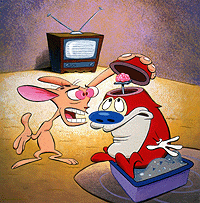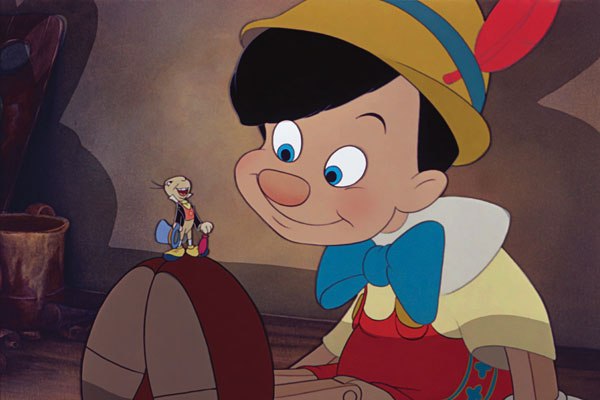Dr. Toon analyzes a critical period when American animation underwent a spirited revival.
Animation is roughly a 120-year old endeavor. As such, we have witnessed countless changes. No animator using the rice paper/cut-and-slash techniques of the 1900s foresaw the advent of sophisticated software systems that enable the motion-capture marvels playing in theaters today. In the same vein, animation itself as a cultural phenomenon has a varied history, with distinct periods of ebb and flow, highs and lows.
A good example is the year 1940 (it would probably be more accurate to say the period 1938-1940, allowing for production schedules). That single year was the Cambrian explosion in the evolution of animation; Pinocchio, Fantasia, Tom and Jerry (MGM), Mighty Mouse, and Woody Woodpecker, not to mention the first definitive Bugs Bunny short, all appeared in theaters. This supernova period of animation history is virtually unequalled.
On the other hand, we have the era spanning 1965-1987, when animation ground to a creative standstill. During this time Hanna-Barbera was mired in the depths of mediocrity. Watchdog groups had banished superheroes and any portrayal of physical conflict. Viewing blocks once reserved for cartoons featured the hallucinatory live-action offerings of Sid and Marty Kroft. Once federally approved deregulation hit the networks, Saturday mornings (and weekday afternoons, thanks to syndication), were inundated with what were, in effect, extended toy commercials.

In the theaters, quality animated films were few and tended to be the exception to the rule. The theatrical short was dead. Ralph Bakshi had some brilliant, uneven moments, but Disney released subpar efforts such as The Aristocats, Robin Hood, and The Black Cauldron. Beginning in 1984, the animated toy ads migrated to the theaters in a dull parade of Care Bears, Strawberry Shortcakes, and multicolored ponies. The era did have some apologists, notably Timothy and Kevin Burke, whose manifesto Saturday Morning Fever merely highlights how much dross was actually on the airwaves. John Kricfalusi summed it up nicely when he remembers that his formative years in the business was spent working on “some of the crappiest cartoons ever made.”
However, animation is a hardy, resilient art form. As it originates from the highest levels of human creativity, it is also unconquerable. The return of American animation to glory began in early 1987 and is, for the most part, still in effect (although with one notable, temporary downturn). What follows is an analysis of how animation turned itself around, just when it seemed it might never answer the bell again.

In a way, this piece relates to last month’s column concerning films that should have made the National Film Registry, because two of the films mentioned were instrumental in animation’s resurrection. I would prefer not to reiterate previous material except to note that Roger Rabbit owed its success to the revival of classic animated characters that captured the public’s heart anew. The film also inspired Steven Spielberg to jump-start a new generation of hipper, smarter animation for television.
The Little Mermaid, as mentioned, birthed a new formula in animated feature films by merging American musical theater with animation. The new hybrid maintained supremacy at all major studios until the CGI films produced by Pixar began to supplant them. However, it must be noted that these two films did not do all the heavy lifting as animation rose to the forefront again. Other factors, contiguous in time, contributed to the New Wave. Some of the contributors from 1987-90:
The Return of the Warner Theatrical Short
In 1969, Warner Studio released a Cool Cat cartoon called Injun Trouble. This cartoon was officially the last animation short that Warner produced. Eighteen years later, directors Greg Ford and Terry Lennon returned Warner characters to the multiplexes when The Duxorcist, a Daffy Duck cartoon made the theatrical rounds in 1987. It was followed the next year by Night of the Living Duck, (Ford and Lennon, Dir.) and in 1990 by Box Office Bunny (Darrell Van Citters, Dir.). The latter was released in conjunction with Bugs Bunny’s 50th birthday and marked the first time Mel Blanc did not voice the rabbit; Jeff Bergman had the honors. Box Office Bunny showcased Bugs as the star of a short for the first time since 1964.
Lennon and Ford continued pushing Warners’ stars back into the cultural spotlight: 1988 saw CBS air the television special Bugs Vs. Daffy: Battle of the Music Video Stars. Interestingly, the “music videos” consisted of clips from old Warner theatrical shorts. This served to rekindle interest in Warner history and what would come to be called “Classic Looney Tunes”.

AKIRA (1988)
Watch out America. Astro Boy was charming, Speed Racer was fun, and Kimba the White Lion certainly was cute, but Katsuhiro Otomo’s cyberpunk version of bio-techno Armageddon changed American perceptions of Japanimation (later known as anime) forever. Scripted from Otomo’s own manga, Akira exploded into US theaters and created the first true generation of American otaku. It would not take long for anime influences to permeate American animation in both stylistic and narrative form. If you seek the origins of popular TV series such as Ben10, look no further.
THE SIMPSONS (1989-Present)
The longest running and arguably the most popular animated TV sitcom of all time. The Simpsons took root in and contributed to the fertile soil generated by the animation revival of 1987-90. The show initially seemed to spotlight Bart Simpson, but a conceptual reworking gave each member of the family – as well as supporting cast members – star turns. The Simpsons was easily the most satirical and self-referential animated series ever aired, surpassing even Jay Ward’s Rocky and His Friends. The sophisticated humor had a payoff: The Simpsons was a prime time offering, paving the way for adult-oriented animation to compete with live-action evening entertainment.
There was a downside to this success. The Prime-Time Animation Summer of 2000 took inspiration from the long-term success of The Simpsons. However, too many poor-quality shows, pitched by hopeful auteurs with no experience in the art or business of animation, were green-lighted by the networks. Almost none of them lasted thirteen episodes. These steps backward in animation’s New Wave did not occur because animation was losing steam; rather, they were the result of inexperienced and naïve creators and undiscriminating network executives.
The Revival Triumphant
Between 1990 and 1995, several high-quality series graced the small screen. As mentioned earlier, Steven Spielberg rolled out imaginative material such as Tiny Toon Adventures (1990-92), a witty re-imagining of the Warner universe. The Animaniacs (1993-98) continued the Warner revival. The Tick (1994-96) was an absurdist take on the superhero genre suitable for adults as well as kids. The underrated Freakazoid (1995-97) followed in The Tick’s mighty footsteps.
Most influential of all was the “dark deco” revival of one of America’s most beloved superheroes. After working on some of Warners’ best new shows, Bruce Timm and Eric Radomski unveiled Batman: The Animated Series (1992-95). By far the most mature, complex handling of the character to date in an animated series, BTAS completed the bridge from dreary animated toy commercials to a full-fledged revival of televised glory. In theaters, 1991 saw Beauty and the Beast gain the first nomination of an animated film for Best Picture.

Rise of the Cable Networks 1992-Present
Now that the revival of American animation was underway, it was perhaps no coincidence that the tide raised higher with the advent of Cartoon Network (1992) and Nickelodeon (rebranded 1984-90, 1990-present). Classic cartoons, including many not televised in many years, were now available 24/7 on Cartoon Network. The purchase of the Hanna-Barbera studio by Turner Broadcasting added more programming. It is ironic that many of the same cartoon series featured came from the floundering era before the revival, now cast in a nostalgic glow. Nickelodeon was quick to initiate original programming, and two of their cartoons, Rugrats and The Ren and Stimpy Show (both 1991) were notable examples of animation’s new capabilities to entertain.
The Cycle Ends

The revival, then, had its roots in the period 1987-90 and continued until 1995. In that final year, Pixar’s Toy Story began an astonishing parade offeature films consisting entirely of computer-generated images. Technical proficiency was only part of the film’s appeal; the superlative script and endearing characters made Toy Story the definitive springboard for future CGI successes, many of which belonged to Pixar. The wonders of animation software soon extended to television productions, and series such as Reboot (1994) and The Adventures of Jimmy Neutron: Boy Genius (2002) gained extensive popularity.
That is not to say that animation went into decline once the revival ended; indeed, it is flourishing in novel ways. 1987-1995 can best be considered a time of renewal, a period where animation’s decline ended and its fortunes reversed for the better. This era also demarcated the line between animation solely cherished by children and animation that adults can freely enjoy. Animation critics may find marring and rough spots in this era, shows that did not reflect the overall creative efforts of the time, but for every one of them there is a Batman or a King of the Hill vying with Futurama to refute them. In the end, animation is a cyclical art form; it will ever be the job of the animation historian and critic to chart and comment upon the changes.
--
Martin "Dr. Toon" Goodman is a longtime student and fan of animation. He lives in Anderson, Indiana.
Dan Sarto is Publisher and Editor-in-Chief of Animation World Network.










